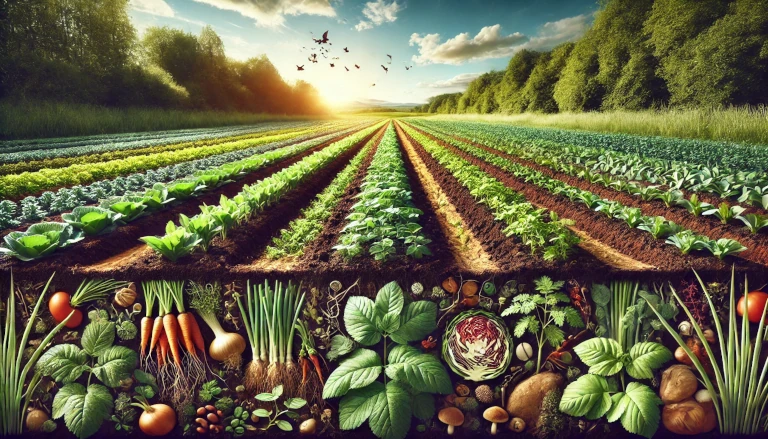Regenerative agriculture is a farming approach focused on restoring and enhancing soil health, increasing biodiversity, and improving the overall resilience of agricultural systems. Unlike conventional methods that can deplete soil and damage ecosystems, regenerative practices aim to rebuild organic matter, sequester carbon, and support sustainable food production. By embracing regenerative agriculture, farmers can create systems that are not only productive but also ecologically responsible.
What is Regenerative Agriculture? 🌱
Regenerative agriculture is a holistic farming system designed to improve soil health and ecosystem diversity. It involves techniques like cover cropping, no-till farming, companion planting, and agroforestry, which together create a self-sustaining, balanced environment. This method emphasizes soil regeneration through natural processes, reducing the need for chemical inputs and mitigating climate change impacts.
Core Principles of Regenerative Agriculture:
- Improving Soil Health 🌍:
Practices like no-till farming and composting enhance soil structure and promote microbial activity. Healthier soils retain more water, reduce erosion, and lead to better crop resilience. - Promoting Biodiversity 🐞:
By incorporating diverse crops, livestock, and plants, regenerative agriculture supports various species and encourages natural pest control, reducing the need for chemical pesticides. - Carbon Sequestration 🌾:
Plants in regenerative systems absorb CO₂ and store it in the soil, helping to mitigate climate change. Techniques like agroforestry—where trees are integrated into farming landscapes—contribute significantly to carbon storage.
Key Practices in Regenerative Agriculture 🌾
- Cover Cropping 🌻:
Planting cover crops between growing seasons prevents soil erosion, adds organic matter, and enriches nutrients. Common cover crops include clover, rye, and alfalfa, which protect soil and promote nitrogen fixation. - No-Till Farming 🚜:
Avoiding soil disturbance by minimizing tilling maintains soil structure and preserves beneficial organisms. No-till farming reduces erosion, improves water retention, and supports healthier plant roots. - Agroforestry 🌳:
Agroforestry integrates trees with crops and livestock, enhancing biodiversity and creating more resilient ecosystems. Trees offer shade, act as windbreaks, and improve soil health through leaf litter and root activity. - Rotational Grazing 🐄:
Moving livestock between pastures allows grasses to recover, improves soil quality, and prevents overgrazing. Rotational grazing mimics natural grazing patterns and promotes healthier ecosystems.
The Benefits of Regenerative Agriculture for Farmers and the Planet 🌍
- Enhanced Soil Fertility 🌱:
By rebuilding soil organic matter, regenerative agriculture improves soil structure, nutrient availability, and water retention. This leads to healthier crops and reduces the need for chemical fertilizers. - Increased Biodiversity 🐝:
Diverse farming systems attract beneficial insects, birds, and other wildlife, creating balanced ecosystems. Natural predators help control pests, reducing dependence on pesticides. - Resilience to Climate Change 🌦️:
Regenerative systems improve water absorption and reduce soil erosion, helping farms withstand extreme weather. Carbon sequestration also contributes to climate mitigation by lowering greenhouse gases. - Economic Benefits 💰:
Healthier soils and ecosystems can reduce input costs, increase yields, and improve long-term profitability. Consumers are also increasingly interested in sustainably produced foods, creating market opportunities for regenerative farmers.
Example of Regenerative Agriculture in Practice 🌾
A regenerative farm might use cover crops to improve soil between main crops, avoid tilling to maintain soil structure, and practice agroforestry by planting trees among crop rows. Livestock is rotated between pastures, grazing on cover crops and contributing manure to enrich the soil. This closed-loop system reduces external inputs, enhances biodiversity, and supports sustainable food production.
Embracing Regenerative Agriculture for a Sustainable Future 🌱
Regenerative agriculture offers a pathway to sustainable farming by focusing on soil health, biodiversity, and ecosystem resilience. By adopting regenerative practices, farmers can improve crop yields, enhance soil fertility, and contribute to climate solutions. This holistic approach is not only beneficial for farmers but also vital for creating a healthier planet for future generations.
Discover more from Green Ecosystem - Renewable Energy, Agriculture, and Environmental Sustainability
Subscribe to get the latest posts sent to your email.


